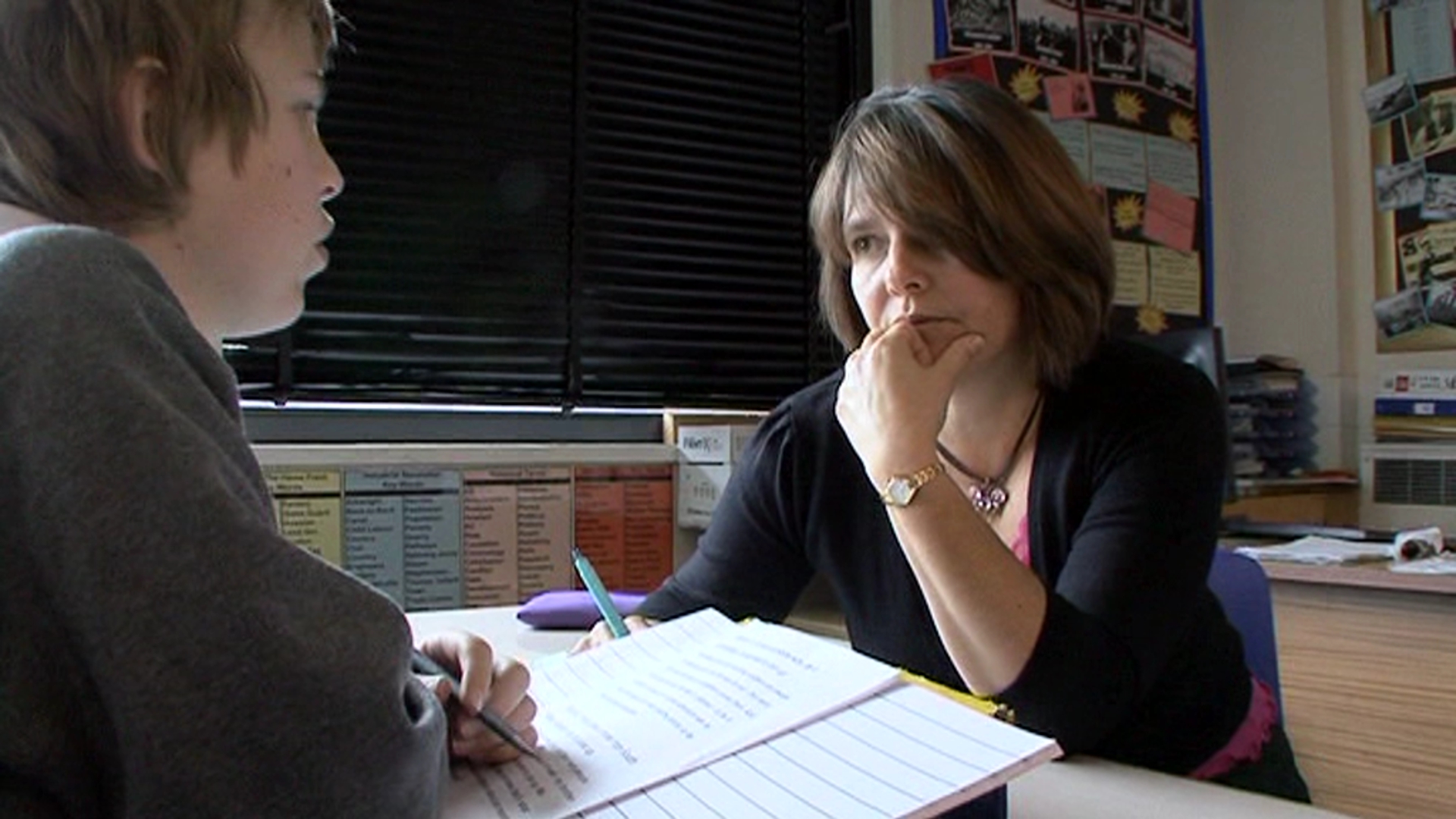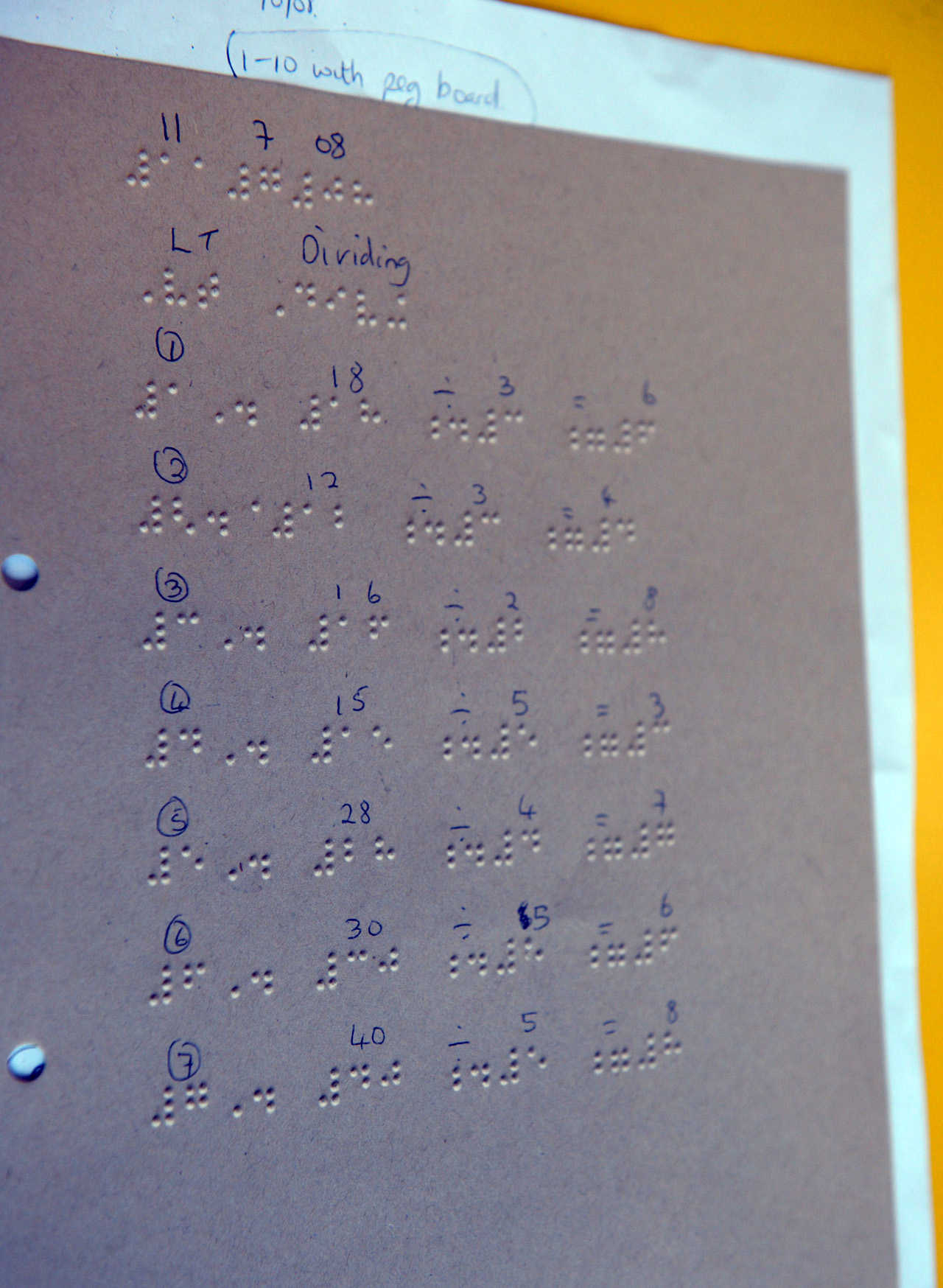Background
Jake is a 15 year old studying for his GCSEs.
Jake has been learning braille for a number of years but although his reading is accurate, it is too slow to tackle long passages or to scan a braille book looking for answers.
Medium assessment
Observation...
Watch Jake working in a one to one session with support provided for an English assignment.
Select this link for a transcript of the video clip.The transcript opens in a new window.
- What senses is he using to access the 'Strange incident of the dog in the night'?
- What learning media is he using in this exercise ?
- What is his print reading distance?
- What would you say is his primary learning medium?
Select 'reveal' for an expert opinion.
The feedback will appear directly after the reveal button.
Observation...
Now watch two clips of Jake in a maths support session.
Select this link for a transcript of the first video clip.The transcript opens in a new window.Select this link for a transcript of the second video clip.The transcript opens in a new window.
Again consider the same four questions:
- What senses is he using to access this fractions exercise?
- What learning media is he using in this exercise ?
- What is his print reading distance?
- What would you say is his primary learning medium in this activity?
Select 'reveal' for an expert opinion.
The feedback will appear directly after the reveal button.
Thinkabout...
What recommendations would you make going forward?
Obviously, from the limited information available from the video clips, you couldn't make any decisions or recommendations. As we saw in introduction section, the LMA process is a team effort that contains a variety of inputs and careful record keeping and discussion.
Task...
However with that in mind what do you think about Jake's use of learning media as seen in the clips?
Note down points that occur to you and then select 'reveal' for an expert opinion.
The feedback will appear directly after the reveal button.
In Jake's case he has access to the following literacy tools:
Reading tools:
- Use of regular print with enlargement where appropriate eg use of LVA, CCTV
- Digitally recorded materials on Ipad eg Daisy format books
- Live reader
- Laptop with speech
Writing tools
- Handwriting using felt tip
- Touch typing word processing
- Limited use of an emanuensis
- Handheld digital recorder for note taking or recording answers
Jake has developed braille reading and writing skills. However, his personal preference is for audio and print.
Even if Jake's eye condition were to deteriorate then he has a range of options and skills that he can apply to literacy tasks. It might be counter productive to insist that Jake does all his schoolwork in braille. Jake needs guidance on how to continue to develop his skills and deploy them efficiently.
Task...
What would you say the benefits of an LMA assessment would be for Jake? Jot down in a notebook up to three key benefits and then compare them with this expert view.
The feedback will appear directly after the reveal button.
The LMA assessment provides evidence for informing decision making.
- An evidenced summary of Jake's progress in literacy through the current learning media eg results of records of previous assessments (Form 1)
- Evidence of the use that Jake is currently making of his different senses across a range of education related tasks (Form 2)
- Evidence of the learning media that Jake currently uses and an indication of the additional media (eg braille note) he might benefit from with additional instruction. (Form 3)
- Evidence of Jake's working distances, size preference and a judgement as to whether the balance of Jake's existing learning media continues to meet his needs.
Thinkabout...
In cases where the evidence of the LMA supports the need for the introduction of braille to a pupil in secondary school , what should I be thinking about?
An older pupil transferring from print to braille will need the same degree of exposure to braille as younger pupils, but fitting this into an already pressured curriculum will create difficulties. A possible solution would be to suspend the pupil's studies for a year and focus on developing braille and related study skills and mobility and independence skills.
This may be necessary if the pupil has experienced a catastrophic injury or illness but, for the pupil who has no additional needs, the negative social consequences of being withdrawn from studies with their classmates and possibly taking up their studies again after a year, possibly with a younger year group, will probably outweigh any potential benefits.

Pupils will need some individualised teaching time out of lessons for braille tuition and also time to practise braille every night. To allow this some classwork or homework assignments could be completed in alternate ways to save the pupil time - for example in assignments that require reading and then written answers, a TA or a member of the family could read from the print textbook to the pupil and the pupil could dictate the answers.
At this important transition point, key staff need to give positive messages about braille and show enthusiasm and avoid any sense that braille is an inferior substitute for print literacy. QTVIs will need to listen carefully to the pupil's wishes and concerns and be open and supportive.
All pupils with severe low vision should have regular (annual) learning media assessments. Children with deteriorating vision should have had their situation regularly monitored and discussions may already have taken place about the possibility of either transferring from print to braille, or introducing braille alongside print.
Some children with stable but severe low vision may reach the stage where print alone is no longer a sufficiently efficient medium for their learning needs and braille instruction will need to be introduced alongside print. They may also become dual print and braille users.
Results from regular assessments of literacy skills (refer to 'Assessing braille literacy' material) especially in relation to reading speed, accuracy and comprehension repeated over time will be invaluable in informing the decision to transfer. Portfolios of the child's written work over time of the child's writing can provide helpful comparisons with the child's current performance levels.
It is important that both the pupil and parents/caregivers are involved in any assessments and are party to, and understand, the process of decision making regarding the introduction of braille. The decision process should be transparent, and all the implications of the impact on the child's access to the curriculum and attainment need to be discussed, and the LMA can be a useful beginning point for these conversations.
Video...
Listen to this teacher talking about the range of factors that need to be considered when taking decisions about transfer from print to braille.
Select this link for a transcript of the video clip.
- Who does Marion think are the key people involved in the decision?
- What are your initial thoughts about the differences between transfer to braille for an eight year old compared to a fifteen year old?
As braille learning progresses, homework and classwork assignments can gradually be presented in braille, beginning with short, simple tasks.
Fundamental to success is effective support from those around the pupil. The Teaching Assistant needs well developed knowledge of the braille code and opportunities to meet regularly with the QTVI to plan interventions and review progress. The QTVI needs to organise planning meetings with all the professionals around the pupil.
At secondary school level the QTVI and individual subject teachers will need to plan together so that the pupil does not fall behind in curriculum subjects. One goal will be to make sure that the pupil is not overloaded and braille learning does not becomes a chore. It may be necessary to review the timetable or curriculum to see if any subjects or activities could be dropped to allow focus on braille learning.
It is important that pupils remain, as far as possible, in control of their braille learning. To this end, they should be supported in making appropriate decisions regarding which medium to use for various tasks (if print can still be used to some degree) and when to use technology.

Video...
Watch the video of Jo Hogg talking about the challenges of organising support for pupils who are transferring from print to braille.
Select this link for a transcript of the video clip.
- As you listen try to identify five ideas that you could incorporate into your own approach and thinking.
Thinkabout...
How much time for braille instruction will late pupils need and how long before they become fluent braille readers?
Task...
Ask any colleagues who have taught late beginners about the timescales involved in individual cases.
What was the quickest time reported to develop effective reading skills?
Inevitably the answer to the question 'how long before they become fluent braille readers?' is 'that it depends on the individual and the circumstances'. Most sources agree that pupils transferring to braille require daily instruction, particularly in the early stages.
'Crash' courses in braille may have negative effects and as John Lorimer (1978) pointed out, 'for braille to become a useful tool the pace of instruction should be geared to the learning pace of the individual'.
The pace of learning will of course in turn be heavily influenced by a range of factors including the pupil's degree of motivation, determination, intelligence and the quality of the instruction they receive. The evidence for learning time is mostly anecdotal, most authors are understandably cautious about committing themselves on this point.
Lorimer (1977) quotes the instance of an 11 year old girl who achieved a reading rate of 50 WPM and mastery of the code after three months of instruction but concluded 'it is more usual for a pupil of average ability who receives tutition at least twice a week to become reasonably competent in the use of braille within six months'.
Even these are vague timescales and are based on the performance of children in specials schools for the blind 30-40 years ago, but they are probably as close as we will get to an answer to the question of 'how long?'
Conclusion
Video...
Finally, listen to these thoughts from Marion Broadhurst.
Select this link for a transcript of the video clip.
You can see that for even the most experienced QTVIs, the issues in transfer from print to braille are often complex and challenging, but the LMA can support and even underpin this process.